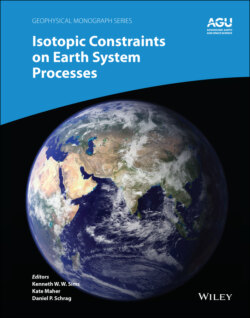Читать книгу Isotopic Constraints on Earth System Processes - Группа авторов - Страница 14
PART II: LOW‐TEMPERATURE/SHALLOW EARTH PROCESSES
ОглавлениеIn Chapter Eight, Laakso and Schrag address the paradox of the apparently stable record of δ13C in carbonate rocks in the face of external evidence for early periods of low atmospheric oxygen. To reconcile the paradox, they link models for the C and O cycles to propose an additional negative feedback between precipitation of isotopically light authigenic carbonates, which results in relatively stable carbon isotopes in carbonate platforms even during shifts in organic carbon burial. Schrag was introduced to thinking about the carbon cycle and its links to climate when he, as DePaolo’s first student at Berkeley, was sent to the University of Chicago to work with Frank Richter, playing a small part in a collaboration between DePaolo and Richter that has persisted for more than 35 years.
Inspired by John Christensen’s landmark paper with Don on zoned garnet Rb‐Sr chronology (Christensen et al., 1989), Ph.D. student Ethan Baxter became interested in refining garnet geochronology utilizing Don’s first love: the Sm‐Nd system. This led to his first paper with Don on the topic (Baxter et al., 2002) and to many subsequent years of work on Sm‐Nd garnet petrochronology since then (see Baxter et al., 2017, for an overview). Chapter Nine by Maneiro et al. represents a significant methodological advance that would have been considered impossible twenty years ago: the ability to date single grains of detrital garnet in the sedimentary record. These advances – including sub‐nanogram analysis of Nd by thermal ionization mass spectrometry (TIMS) – are an extension of Don’s pioneering contributions to Sm‐Nd analytical methods and applications.
Chapter Ten provides an overview of efforts to use the stable isotope ratios of redox‐active elements to track critically important redox reactions in modern and ancient environments. This line of research arose from a very fortunate confluence of factors at Berkeley around 1995: The DePaolo group was developing groundwater‐related research directions and was beginning work on novel isotope measurements (i.e. 44Ca/40Ca and 11B/10B), some of which employed the double spike method. Researchers at Lawrence Berkeley National Laboratory were working intensely on the environmental geochemistry of Se, and Tom Bullen at USGS Menlo Park was interested in Se isotopes. These were all necessary ingredients for the development of Se isotope measurements and environmental applications. Once that path was established, work on the other elements followed naturally.
Chapters Eleven and Twelve, originally submitted as a single contribution, are presented as a pair of chapters. The first (Turchyn & Druhan) provides an overview of how reactive transport effects manifest in S isotope signatures; the second (Druhan & Turchyn) reports a model‐based study of coupled sulfur and calcium isotope fractionation in open systems. Although Don has not worked much with the S isotope system specifically, he has both explored and exposed the power of using two isotope systems that differ in their reactivity or transport within a given system to understand and quantitatively constrain reactive flow (DePaolo, 2006). This is, in many ways, the bedrock of isotope‐enabled reactive transport modeling and this work explores and expands on these fundamental concepts. Don used this paired isotope approach to great success in exploring the relative evolution of strontium and oxygen in hydrothermal systems, allowing him to independently calculate flow velocity and fracture spacing. Chapters Eleven and Twelve expand on this work to explore the utility of calcium and sulfur isotope dynamics under conditions of microbially induced carbonate mineralization.
In Chapter Thirteen, Messa et al. build upon much of the original stable Ca isotope research that Don was involved in when “Biological control of calcium isotopic abundances in the global calcium cycle” was published by Skulan et al. in 1997. This work, of which Don was second author on, was one of the original projects that illustrated stable Ca isotope fractionation within food chains, revealing that predators exhibit lighter stable Ca isotope ratios than their prey. This chapter expands upon this discovery, and a subsequent study by Skulan and DePaolo (1999), by detailing how stable Ca isotope ratios can reveal more than trophic level positioning, but also inter‐organism Ca isotope fractionation caused by diverse metabolic processes such as the generation of various hard tissues throughout an individual’s lifecycle.
The editors and authors gratefully acknowledge the reviewers’ comments, which greatly improved the manuscripts herein. We also wish to express our gratitude for the hard work, thoughtful comments, and diligence of the editorial staff at AGU and Wiley.
Kenneth W. W. Sims Department of Geology and Geophysics University of Wyoming, USA
Kate Maher School of Earth, Energy and Environmental Sciences Stanford University, USA
Daniel P. Schrag Department of Earth and Planetary Sciences Harvard University, USA
